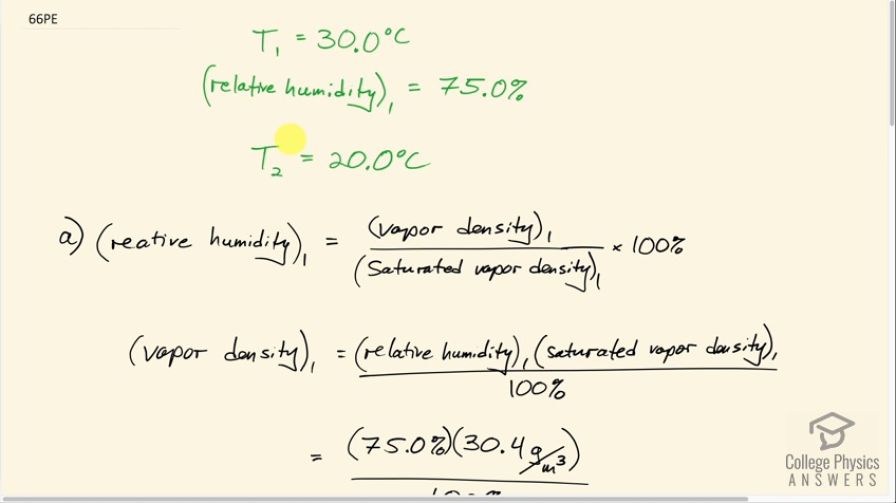Question
One day the relative humidity is 75.0% , and that
evening the temperature drops to , well below the
dew point. (a) How many grams of water condense from each cubic meter of air? (b) How much heat transfer occurs by this condensation? (c) What temperature increase could this cause in dry air?
Final Answer
Solution video
OpenStax College Physics, Chapter 14, Problem 66 (Problems & Exercises)

vote with a rating of
votes with an average rating of
.
Calculator Screenshots
Video Transcript
This is College Physics Answers with Shaun Dychko. When the temperature is 30 degrees Celsius, we are told that the relative humidity is 75.0 percent and the temperature then decreases to some temperature T 2 which is 20.0 degrees Celsius and the question is in part (a), how much water condenses out of the air per cubic meter? So the relative humidity in temperature 1 is the vapor density divided by the saturated vapor density and so we have to look up the saturation vapor density in this table [13.5] here and it says that at 30 degrees Celsius, the saturation vapor density is 30.4 grams per cubic meter and we'll rearrange this first though to solve for the vapor density. So we'll multiply both sides by the saturation vapor density and divide both sides by 100 and we end up with this line here and then we plug in 75.0 percent times 30.4 grams per cubic meter; this works out to 22.8 grams per cubic meter. So that's the mass of water in each cubic meter of air. Now at 20 degrees Celsius— so this is at temperature 2, 20 degrees Celsius— it is impossible to have this many grams in each cubic meter of air. We can look up in that table again the maximum possible amount of water per cubic meter and that's 17.2 grams per cubic meter at 20 degrees Celsius. So the difference between the vapor density that we start with and the maximum that's possible at this new temperature is going to be the amount that condenses out. So we have 22.8 grams per cubic meter minus 17.2 and that gives 5.60 grams per cubic meter. Now part (b), we are asked how many joules per cubic meter of energy are released due to this phase change from the vapor into the condensed liquid? So the mass per volume is 5.60 grams per cubic meter and we multiply that by the latent heat of fusion at 37.0 degrees. Now of course the air is not 37.0 degrees but the textbook gives us the latent heat of vaporization at 37.0 and that's much better number to use than the value at 100 degrees Celsius. So we are not gonna use 2256 because that's true when the water is at 100 degrees Celsius and in this question, the water is at 20.0 degrees Celsius and 37.0 is much closer to 20.0 than 100.0 is. So we end up with 1.31 times 10 to the 4 joules per cubic meter. Now the next question in part (c) says how much would the temperature increase assuming the air was dry based on this much energy being released per cubic meter? So we have the mass of the air times its specific heat times the change in temperature and we are gonna solve for ΔT but first let's replace the mass with something in terms of volume and density because we don't know what the mass of the air is. And so density is mass per volume and we multiply both sides by V and we get mass is density times volume and we make a substitution for m here and these volume's cancel and we are left with Q over V equals ρcΔT. So we can solve for ΔT by dividing both sides by ρ and c and we get that the change in temperature then is the energy per volume which we found in part (b) divided by the density times specific heat. So that's 1.3104 times 10 to the 4 joules per cubic meter divided by 1.29 kilograms per cubic meter times 721 joules per kilogram per Celsius degrees— specific heat for dry air— and this is 14.1 Celsius degrees.

